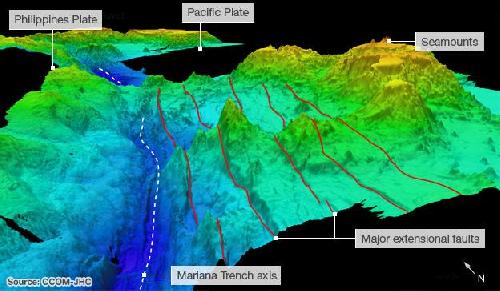NEWPORT, Ore. - For what may be the first time, scientists have eavesdropped on the deepest part of the world's oceans and instead of finding a sea of silence, they discovered a cacophony of sounds both natural and caused by humans.
For three weeks, a titanium-encased hydrophone recorded ambient noise from the ocean floor at a depth of more than 36,000 feet in a trough known as Challenger Deep in the fabled Mariana Trench near Micronesia. The team of researchers from the National Oceanic and Atmospheric Administration, Oregon State University and the U.S. Coast Guard expected to hear little. They were surprised.
"You would think that the deepest part of the ocean would be one of the quietest places on Earth," said Robert Dziak, a NOAA research oceanographer and chief scientist on the project. "Yet there really is almost constant noise from both natural and man-made sources. The ambient sound field at Challenger Deep is dominated by the sound of earthquakes, both near and far was well as the distinct moans of baleen whales and the overwhelming clamor of a category 4 typhoon that just happened to pass overhead.
 The Mariana Trench and surrounding terrain is seen in this graphic. Credit: Center for Coastal and Ocean Mapping - Joint Hydrographic Center
The Mariana Trench and surrounding terrain is seen in this graphic. Credit: Center for Coastal and Ocean Mapping - Joint Hydrographic Center
"There was also a lot of noise from ship traffic, identifiable by the clear sound pattern the ship propellers make when they pass by," added Dziak, who has a courtesy appointment in Oregon State's College of Earth, Ocean, and Atmospheric Sciences. "Guam is very close to Challenger Deep and is a regional hub for container shipping with China and The Philippines."
The project, which was funded by the NOAA Office of Ocean Exploration and Research, was designed to establish a baseline for ambient noise in the deepest part of the Pacific Ocean. Anthropogenic, or human-caused noise has increased steadily over the past several decades and getting these first recordings will allow scientists in the future to determine if the noise levels are growing.
Getting those first sounds wasn't easy.
The bottom of the Challenger Deep trough is roughly seven miles below the ocean's surface. In fact, you could put the world's tallest peak - Mount Everest - in the trench and its top would still be more than a mile from the surface.
The pressure at that depth is incredible, said Haru Matsumoto, an Oregon State ocean engineer who along with NOAA engineer Chris Meinig helped to develop a hydrophone capable of withstanding such pressure. In the average person's home or office, the atmospheric pressure is about 14.7 pounds per square inch; at the bottom of the Mariana Trench, it is more than 16,000 PSI.
"We had never put a hydrophone deeper than a mile or so below the surface, so putting an instrument down some seven miles into the ocean was daunting," Matsumoto said. "We had to drop the hydrophone mooring down through the water column at no more than about five meters per second. Structures don't like rapid change and we were afraid we would crack the ceramic housing outside the hydrophone."
Partnering with the U.S. Coast Guard, the researchers deployed the hydrophone from the Guam-based cutter Sequoia in July 2015. It took more than six hours for the instrument package to free-fall to the bottom of the Mariana Trench. Its recordings filled the flash drive in about 23 days, but the researchers had to wait until November to retrieve the hydrophone because of ships' schedules and persistent typhoons.
Once back on site, they recovered the hydrophone mooring by sending an acoustic signal from the ship above, triggering its release from the seafloor. Attached floats allowed it to gradually ascend to the surface.
"It is akin to sending a deep-space probe to the outer solar system," Dziak said. "We're sending out a deep-ocean probe to the unknown reaches of inner space."
For the past several months, Dziak and his colleagues have been analyzing the sounds and differentiating natural sounds from ships and other human activities.
"We recorded a loud magnitude 5.0 earthquake that took place at a depth of about 10 kilometers (or more than six miles) in the nearby ocean crust," Dziak said. "Since our hydrophone was at 11 kilometers, it actually was below the earthquake, which is really an unusual experience. The sound of the typhoon was also dramatic, although the cacophony from big storms tends to be spread out and elevates the overall noise for a period of days."
Matsumoto said the hydrophone also picked up a lot of noise from the surface of the ocean - some seven miles above - including waves and winds disturbing the surface.
"Sound doesn't get as weak as you think it does even that far from the source," he said.
Another OSU co-investigator on the project, Joe Haxel, will lead a planned return to Challenger Deep in 2017, where the researchers will deploy the hydrophone for a longer period of time and attach a deep-ocean camera.
Dziak, Matsumoto and Haxel are affiliated with the Acoustics Program in the NOAA/Pacific Marine Environmental Laboratory and work at OSU's Hatfield Marine Science Center in Newport, Ore. The project in Challenger Deep is one of a number of projects in which the U.S. Coast Guard partners with NOAA to sponsor scientific research.
source: Oregon State University